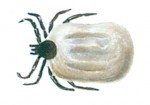
( Latin: Ixodes ricinus)
The adult male is 2 mm long, the female twice this .length, but these measurements only apply to individuals which have not recently fed. The red-brown, leathery skin of the abdomen can stretch to an incredible extent.
This species is very common in some areas, but not in others. This is because it requires special environmental conditions. It is, for instance, sensitive to desiccation and is therefore found mainly in damp undergrowth and other dense vegetation.
A hungry tick will move up to the tip of a grass stem or out on to a leaf and wait there until an animal passes by. The castor bean tick is not fastidious as regards the animal from which it sucks blood. It may use mammals of any size, even man, and also birds and reptiles. When an animal passes by and touches it the tick grips it firmly.
It wanders about on the host until it has found a suitable, preferably thin-skinned, site and then inserts its mouthparts which are serrated and elongated to form a sucking channel.
Neither the piercing of the skin nor the sucking of blood is perceived at the time, but after a period of time the skin starts to itch.
The tick remains on its host for 5-6 days and then releases its grip and falls to the ground, where it seeks shelter and digests its meal. During the course of its life a tick has to find a host on three occasions, twice when young, and once as an adult before it can lay eggs. A female tick may lay more than 2,000 eggs, but these do not survive indoors where the environment is too dry.
When living on its host a tick is very firmly anchored and is not easily removed with forceps. It is, however, essential to remove the whole animal, otherwise inflammation may occur. If anaesthetised with ether, the tick will release its grip and can then be removed. Alternatively it can be smeared with a little fat and after about fifteen minutes it can be picked off.




